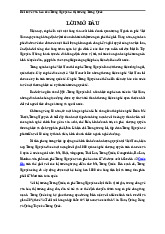



Preview text:
lOMoAR cPSD| 50159245 PROBLEMS 3
a. To estimate the average annual return, we sum up the returns for each year and
divide by the total number of years:
Average return of Scientific Atlanta = (80.95 + (-47.37) + 31 + 132.44 + 32.02 + 25.37
+ (-28.57) + 0 + 11.67 + 36.19) / 10 = 24.23%
Average return of AT&T = (58.26 + (-33.79) + 29.88 + 30.35 + 2.94 + (-4.29) + 28.86
+ (-6.36) + 48.64 + 23.55) / 10 = 17.24%
To estimate the standard deviation of annual returns, we need to calculate the variance
first. The variance is equal to the sum of the squared differences between each annual
return and the average return, divided by the total number of years:
Variance of Scientific Atlanta = [(80.95 - 24.23)^2 + (-47.37 - 24.23)^2 + (31 -
24.23)^2 + (132.44 - 24.23)^2 + (32.02 - 24.23)^2 + (25.37 - 24.23)^2 + (-28.57 -
24.23)^2 + (0 - 24.23)^2 + (11.67 - 24.23)^2 + (36.19 - 24.23)^2] / 10 = 2145.35
Standard deviation of Scientific Atlanta = sqrt(2145.35) = 46.35%
Variance of AT&T = [(58.26 - 17.24)^2 + (-33.79 - 17.24)^2 + (29.88 - 17.24)^2 +
(30.35 - 17.24)^2 + (2.94 - 17.24)^2 + (-4.29 - 17.24)^2 + (28.86 - 17.24)^2 + (-6.36 -
17.24)^2 + (48.64 - 17.24)^2 + (23.55 - 17.24)^2] / 10 = 783.11
Standard deviation of AT&T = sqrt(783.11) = 27.97%
b. To estimate the covariance, we calculate the sum of the product of the differences
between each company's return and their respective average returns, divided by the total number of years:
Covariance = [(80.95 - 24.23)(58.26 - 17.24) + (-47.37 - 24.23)(-33.79 - 17.24) + (31 -
24.23)(29.88 - 17.24) + (132.44 - 24.23)(30.35 - 17.24) + (32.02 - 24.23)(2.94 - 17.24)
+ (25.37 - 24.23)(-4.29 - 17.24) + (-28.57 - 24.23)(28.86 - 17.24) + (0 - 24.23) (-6.36 -
17.24) + (11.67 - 24.23)(48.64 - 17.24) + (36.19 - 24.23)(23.55 - 17.24)] / 10 = 1342.32
To estimate the correlation, we divide the covariance by the product of the standard
deviations of the two companies:
Correlation = Covariance / (Standard deviation of Scientific Atlanta) * (Standard
deviation of AT&T) = 1342.32 / (46.35% * 27.97%) = 1.14 lOMoAR cPSD| 50159245
c. To estimate the variance of a portfolio composed of equal parts of the two
investments, we use the formula:
Variance of portfolio = (0.5^2 * Variance of Scientific Atlanta) + (0.5^2 * Variance of
AT&T) + (2 * 0.5 * 0.5 * Covariance)
Variance of portfolio = (0.5^2 * 2145.35) + (0.5^2 * 783.11) + (2 * 0.5 * 0.5 * 1342.32) = 629.06 PROBLEMS 4 a.
If you were constrained to pick just one asset, you would choose stocks. This
decision is based on the higher average return of stocks (20% compared to 8% for gold). b.
To alleviate your friend's concern about the potential big payoffs of gold, you
could consider evaluating the risk-return tradeoff. While gold may have the potential
for big payoffs, it also has a higher standard deviation (25% compared to 22% for
stocks), indicating higher volatility and risk. By choosing stocks, you are opting for a
higher average return with relatively lower risk. c.
A portfolio composed of equal proportions in gold and stocks would have a
mean return equal to the weighted average of the individual asset returns. In this case,
it would be (0.58%) + (0.520%) = 14%. The variance of the portfolio can be
calculated using the formula: Variance of Portfolio = (Weight of Gold^2 * Variance of
Gold) + (Weight of Stocks^2 * Variance of Stocks) + (2 * Weight of Gold * Weight of Stocks *
Correlation) Substituting the given values: Variance of Portfolio = (0.5^2 * 25%) +
(0.5^2 * 22%) + (2 * 0.5 * 0.5 * -0.4) = 0.0625 + 0.055 + (-0.4) = 0.1175 or 11.75% d.
If GPEC varies the amount of gold it produces with stock prices in the United
States, it would mean that gold supply is inversely related to stock prices. As stock
prices go up, GPEC would produce less gold, and as stock prices go down, GPEC would produce more gold.
This would have an impact on the portfolios as follows: •
In the case of owning only gold, if stock prices go up, gold supply decreases.
This might lead to an increase in gold prices and potentially higher returns for gold investments. lOMoAR cPSD| 50159245 •
In the case of owning only stocks, there would not be a direct impact of gold
production changes on the stock market. However, changes in gold prices, due
to changes in gold supply, might have indirect effects on investor sentiment and market dynamics. •
In the case of a portfolio with equal proportions of gold and stocks, the impact
would depend on the relative magnitudes of the changes in gold prices and
stock prices. If gold prices increase more than stock prices, the portfolio's
overall return might be positively affected. Conversely, if stock prices increase
more than gold prices, the overall return might be negatively affected. The
specific impact would also depend on other factors like demand and market conditions. PROBLEMS 10
To estimate the expected return and standard deviation of the new portfolio, we need
to calculate the weighted average return and standard deviation.
First, let's calculate the expected return of the Vanguard 500 index fund:
Expected Return of Vanguard 500 index fund = 12%
Next, let's calculate the expected return of the treasury bills:
Expected Return of T-bills = 5%
Now, let's calculate the weighted average return of the portfolio:
Weighted Average Return = (Amount invested in Vanguard 500 index fund * Expected
Return of Vanguard 500 index fund) + (Amount invested in T-bills * Expected Return
of T-bills) = (800,000 * 12%) + (200,000 * 5%) = 96,000 + 10,000 = 106,000
Therefore, the expected return of the new portfolio is 106,000.
Now, let's calculate the weighted average standard deviation of the portfolio:
Weighted Average Standard Deviation = √[(Amount invested in Vanguard 500 index
fund)^2 * (Standard Deviation of Vanguard 500 index fund)^2 + (Amount invested in
T-bills)^2 * (Standard Deviation of T-bills)^2 + 2 * (Amount invested in Vanguard 500
index fund) * (Amount invested in T-bills) * (Covariance of Vanguard 500 index fund and T-bills)] lOMoAR cPSD| 50159245
Since the allocation to T-bills is 200,000, the allocation to the Vanguard 500 index fund is 800,000.
Let's assume the covariance of Vanguard 500 index fund and T-bills is 0 (no correlation between the two):
Weighted Average Standard Deviation = √[(800,000)^2 * (25%)^2 + (200,000)^2 *
(0.05)^2 + 2 * (800,000) * (200,000) * (0) ] = √[ 400,000,000 * 0.0625 + 4,000,000 *
0.0025 ] = √[ 25,000,000 + 10,000 ] = √[ 25,010,000 ] = 5,001
Therefore, the standard deviation of the new portfolio is 5,001.
In summary, the expected return of the new portfolio is 106,000 and the standard deviation is 5,001.



